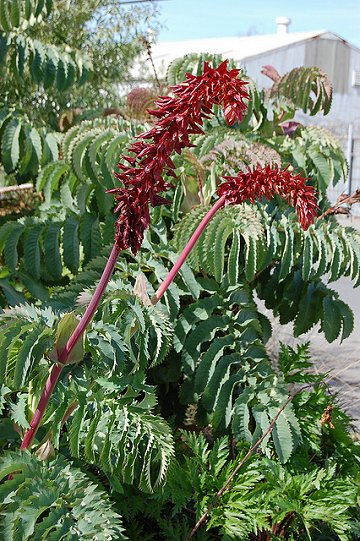
|
|
Honey Flower
(Melianthus major)
|
Honey Flower -
Melianthus major
Melianthus is a genus of flowering plants native to elevated grassland in South Africa. It contains up to six species of evergreen shrubs. They have large pinnate leaves with prominent stipules, and erect racemes of nectar-rich flowers. A common name for these plants is "honey flower", which is also the English translation of the
generic name. The generic name comes from the Greeki meli
(honey), and anthos (flower) referring to the surprisingly large quantities of nectar they
produce. This name also attaches to the species M. major which is found in
cultivation.
The six species of melianthus are indigenous to South
Africa, where their common name is the
Kruidjie-roer-my-nie, which means herb-touch-me-not. This refers to the smell of the
foliage, which some people don't like. If the leaves are crushed, the odour is certainly strong but
not, to my nose at least, unpleasant. M. comosus grows mainly in the dry interior of the country but M. major is more widespread and runs along ditches and
verges. This tendency to colonise areas by runners has made it an unwelcome weed in parts of
Australia. Instead, it is cultivated species in Europe, particularly in Britain.
Melianthus major (giant honey flower or Kruidjie-roer-my-nie) is a species of
flowering plant in the family Melianthaceae. It is an evergreen suckering shrub,
endemic to South Africa and naturalised in India, Australia and New Zealand. It
grows to 2–3 m (7–10 ft) tall by 1–3 m (3–10 ft) wide, with pinnate blue-green
leaves 30–50 cm (12–20 in) long, which have a distinctive odour.
Actively growing during the winter, Melianthus major forms a large shrub suckering and spreading as it
goes. The distinctive large, smooth leaves are a light bluish-green, deeply divided and
ruffled-edged. The bush has several thick stalks with the leaves placed at intervals up the
stem.
The long flower-spikes 30–50 cm (12–20 in)
long, grow out from the top of the stems in spring. The
nectar-rich, bird pollinated flowers rise up above the leaves, drawing attention with their unusual rusty red
colouring. They are followed by pale green, bladder-like pods containing the shiny black
seeds.
On a sunny day the sunbirds feast on the nectar
dripping from the flowers, but any one touching those attractive leaves is in
for a surprise. With a strong unpleasant smell, it warns all that it is highly
toxic. All parts of the plants are poisonous.
Melianthus major is an easy garden plant, grown worldwide for its attractive
foliage. It prefers a warm, sunny position with good drainage. Although quite tough and
adaptable, it will flourish in deep, rich soil, especially if given plenty of
water. Melianthus grows fast and will make a show within a few months. It is particularly attractive in spring when in flower and sporting its new lush leaf growth after the wet Cape
winter.
During the dry summers or whenever the plants are
untidy, they should be cut back hard to encourage new growth. The plants can survive in cold areas with
frost, sending new shoots from the base in spring.
Melianthus grow very easily from seed or cuttings. The seed is sown in autumn in seed trays filled with a
well-drained medium and covered lightly with sand or finely milled bark. Germination is usually within a
month. The young seedlings are potted up into bags or small pots and grown on until strong enough to be planted out into the
garden. The cuttings can be made any time of the year depending on material
available. Cuttings are made from the new shoots sprouting from the base.
Although toxic when taken internally, it is used medicinally by the local
people. They mostly use the leaves to make poultices and decoctions that are applied directly to
wounds, bruises, backache and rheumatic joints. The root is poisonous and emetic, but is used as a remedy against snake bites
The honey-like nectar from the flowers is eaten.
Deliciously sweet, used as sweetener.
Source:
http://en.wikipedia.org/wiki/Melianthus
http://en.wikipedia.org/wiki/Melianthus_major
http://www.plantzafrica.com/plantklm/melianthusmajor.htm
http://www.telegraph.co.uk/gardening/3335888/How-to-grow-Melianthus-major.html
